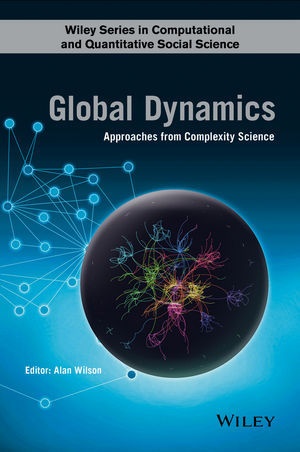Read more
A world model: economies, trade, migration, security and development aid.
This bookprovides the analytical capability to understand and explore the dynamics of globalisation. It is anchored in economic input-output models of over 200 countries and their relationships through trade, migration, security and development aid. The tools of complexity science are brought to bear and mathematical and computer models are developed both for the elements and for an integrated whole. Models are developed at a variety of scales ranging from the global and international trade through a European model of inter-sub-regional migration to piracy in the Gulf and the London riots of 2011. The models embrace the changing technology of international shipping, the impacts of migration on economic development along with changing patterns of military expenditure and development aid. A unique contribution is the level of spatial disaggregation which presents each of 200+ countries and their mutual interdependencies - along with some finer scale analyses of cities and regions. This is the first global model which offers this depth of detail with fully work-out models, these provide tools for policy making at national, European and global scales.
Global dynamics:
* Presents in depth models of global dynamics.
* Provides a world economic model of 200+ countries and their interactions through trade, migration, security and development aid.
* Provides pointers to the deployment of analytical capability through modelling in policy development.
* Features a variety of models that constitute a formidable toolkit for analysis and policy development.
* Offers a demonstration of the practicalities of complexity science concepts.
This book is for practitioners and policy analysts as well as those interested in mathematical model building and complexity science as well as advanced undergraduate and postgraduate level students.
List of contents
Notes on Contributors xiii
Acknowledgements xvii
Part I GLOBAL DYNAMICS AND THE TOOLS OF COMPLEXITY SCIENCE
1 Global Dynamics and the Tools of Complexity Science 3
Alan Wilson
Reference 7
Part II TRADE AND ECONOMIC DEVELOPMENT
2 The Global Trade System and Its Evolution 11
Simone Caschili and Francesca Medda
2.1 The Evolution of the Shipping and Ports' System 11
2.2 Analyses of the Cargo Ship Network 12
2.3 A Complex Adaptive Systems (CASs) Perspective 15
2.4 Conclusions: The Benefits of a Systems Perspective 20
References 21
Appendix 23
A.1 Complexity Science and Complex Adaptive Systems: Key Characteristics 23
A.1.1 Four Properties 24
A.1.2 Three Mechanisms 25
3 An Interdependent Multi-layer Model for Trade 26
Simone Caschili, Francesca Medda, and Alan Wilson
3.1 Introduction 26
3.2 The Interdependent Multi-layer Model: Vertical Integration 27
3.3 Model Layers 30
3.3.1 Economic Layer 30
3.3.2 Social and Cultural Layer (Socio-cultural) 33
3.3.3 Physical Layer 34
3.4 The Workings of the Model 34
3.5 Model Calibration 35
3.6 Result 1: Steady State 39
3.7 Result 2: Estimation and Propagation of Shocks in the IMM 42
3.8 Discussion and Conclusions 48
References 48
4 A Global Inter-country Economic Model Based on Linked Input-Output Models 51
Robert G. Levy, Thomas P. Oléron Evans, and Alan Wilson
4.1 Introduction 51
4.2 Existing Global Economic Models 52
4.3 Description of the Model 53
4.3.1 Outline 53
4.3.2 Introduction to Input-Output Tables 53
4.3.3 A Single Country Model 55
4.3.4 An International Trade Model 57
4.3.5 Setting Model Coefficients from Data 58
4.4 Solving the Model 58
4.4.1 The Leontief Equation 58
4.4.2 The Drawbacks of Mathematical Elegance 59
4.4.3 Algorithm for an Iterative Solution 59
4.5 Analysis 61
4.5.1 Introduction 61
4.5.2 Simple Modelling Approaches 61
4.5.3 A Unified Network Approach 64
4.5.4 Comparison with a Multi-region Input-Output Model 67
4.6 Conclusions 67
Acknowledgements 69
References 69
Appendix 71
A.1 Modelling the 'Rest of the World' 71
A.2 Services Trade Data 71
A.2.1 Importing Own Exports 72
A.2.2 The Rest of the World for Sectors 72
Part III MIGRATION
5 Global Migration Modelling: A Review of Key Policy Needs and Research Centres 75
Adam Dennett and Pablo Mateos
5.1 Introduction 75
5.2 Policy and Migration Research 76
5.2.1 Key Policy Issues in Contemporary Migration Research 76
5.2.2 Linking Policy Issues to Modelling Challenges 81
5.2.3 Policy-related Research Questions for Modellers 82
5.2.4 Other International Migration Modelling Research 83
5.3 Conclusion 84
References 84
Appendix 87
A.1 United Kingdom 87
A.2 Rest of Europe 90
A.3 Rest of the World 94
6 Estimating Inter-regional Migration in Europe 97
Adam Dennett and Alan Wilson
6.1 Introduction 97
6.2 The Spatial System and the Modelling Challenge 98
6.3 Biproportional Fitting Modelling Methodology 100
6.3.1 Model (i) 104
6.3.2 Model (ii) 105
6.3.3 Model (iii) 105
6.3.4 Model (iv) 108
6.3.5 Model (v) 109
6.3.6 Model (v
About the author
Alan Wilson, Centre for Advanced Spatial Analysis, University College London, UK. His research interests have been concerned with many aspects of mathematical modelling and the use of models in planning in relation to all aspects of cities and regions - including demography, economic input-output modelling, transport and locational structures. He was responsible for the introduction of a number of model building techniques which are now in common use internationally. These models have been widely used in areas such as transport planning. He made important contributions through the rigorous deployment of accounts' concepts in demography and economic modelling. In recent years he has been particularly concerned with applications of dynamical systems theory in relation to the task of modelling the evolution of urban structure - initially described in Catastrophe theory and bifurcation: applications to urban and regional systems. His current research, supported by ESRC and EPSRC grants of around ?3M, is on the evolution of cities and the dynamics of global trade and migration.
Summary
A world model: economies, trade, migration, security and development aid. This bookprovides the analytical capability to understand and explore the dynamics of globalisation. It is anchored in economic input-output models of over 200 countries and their relationships through trade, migration, security and development aid.

